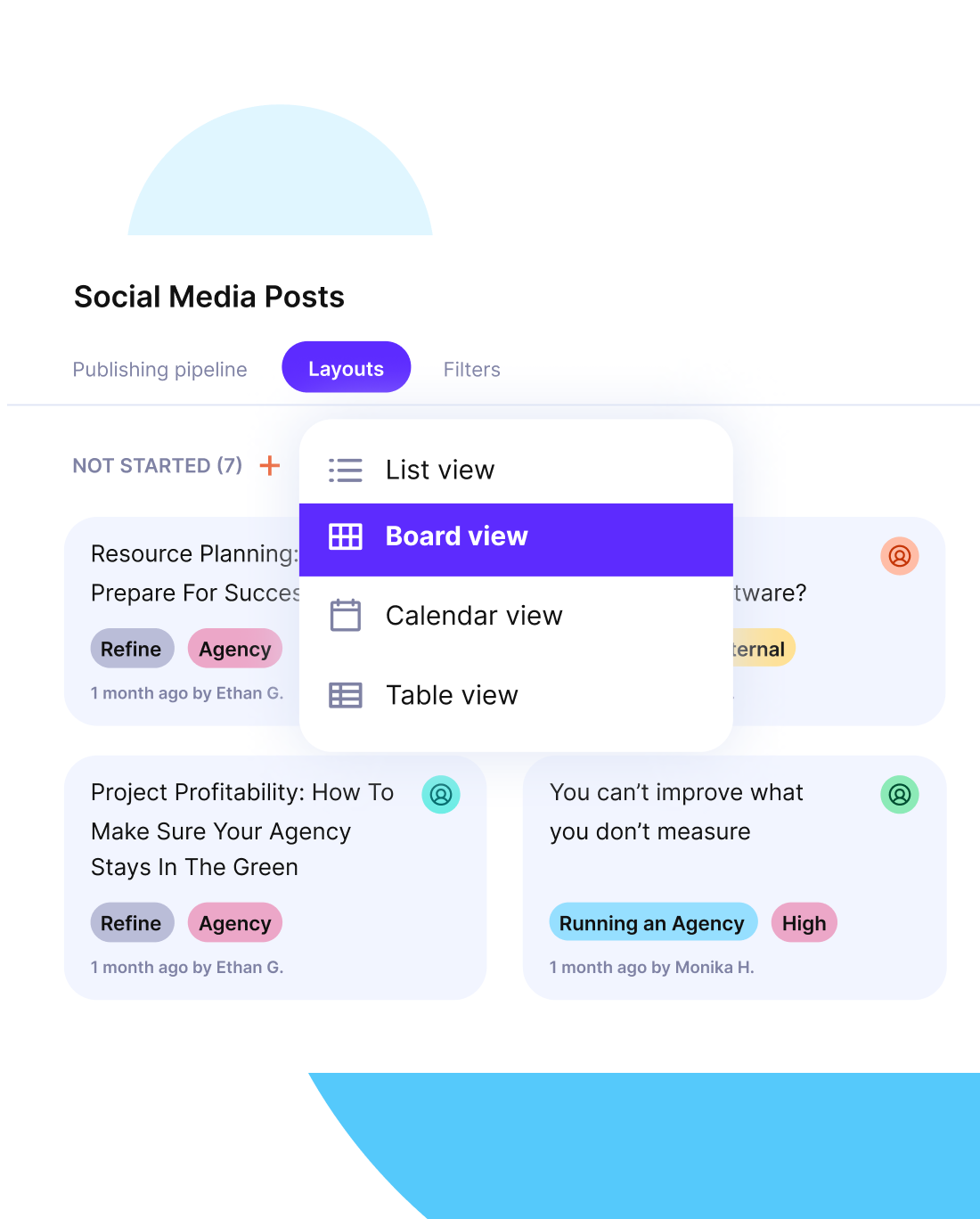What Is Contract Management: How-To Guide + Best Practices
Unorganized contracts lead to missed deadlines, unclear responsibilities, and costly project delays. If this sounds familiar, it’s time to rethink your approach to contract management.
This guide shows you how to manage contracts effectively (from drafting to execution to compliance). We’ll also talk about the best practices, solving common challenges, and must-have tools (along with choosing advice).
Key Takeaways
- Contract management oversees agreements from creation to renewal, minimizing financial risks and ensuring regulatory compliance while maximizing value.
- The contract lifecycle in project management includes five stages: request, negotiation, execution, start-up, and contract monitoring for continuous compliance tracking.
- Effective contract management prevents annual revenue leakage through centralized visibility, automated alerts, and systematic performance reviews.
- Best practices of contract management are pre-approved language, regular compliance audit trails, KPI establishment, and automated monitoring for critical terms, conditions and deadlines.
What Is Contract Management?
Contract management (or contract handling) is the process of creating, executing, and tracking contracts to ensure legal obligations are met, risks are minimized, and value is delivered throughout the contract lifecycle.
Why Is Contract Lifecycle Management So Important?
Each stage of the contract lifecycle management (CLM) carries financial, legal, and operational risk. Managing these steps intentionally prevents delays, reduces disputes, and ensures accountability across stakeholders.
A structured contract management process keeps revenue flowing because it avoids missed payments, compliance failures, and auto-renewals. It also helps enforce timelines, scopes, and performance standards.
We talk much more about the best practices of legal service contracts in our service-level agreement guide.
What Are the Stages of the Contract Lifecycle Process?
The contract lifecycle includes seven key stages: request and inception, negotiation and drafting, execution and signing, start-up and metadata extraction, monitoring and compliance, renewal and renegotiation, and finally, closeout and archiving.
Each stage in the lifecycle has a specific goal and risk profile. Below, we’ll break down the importance of each phase and explain what successful execution looks like at every step.
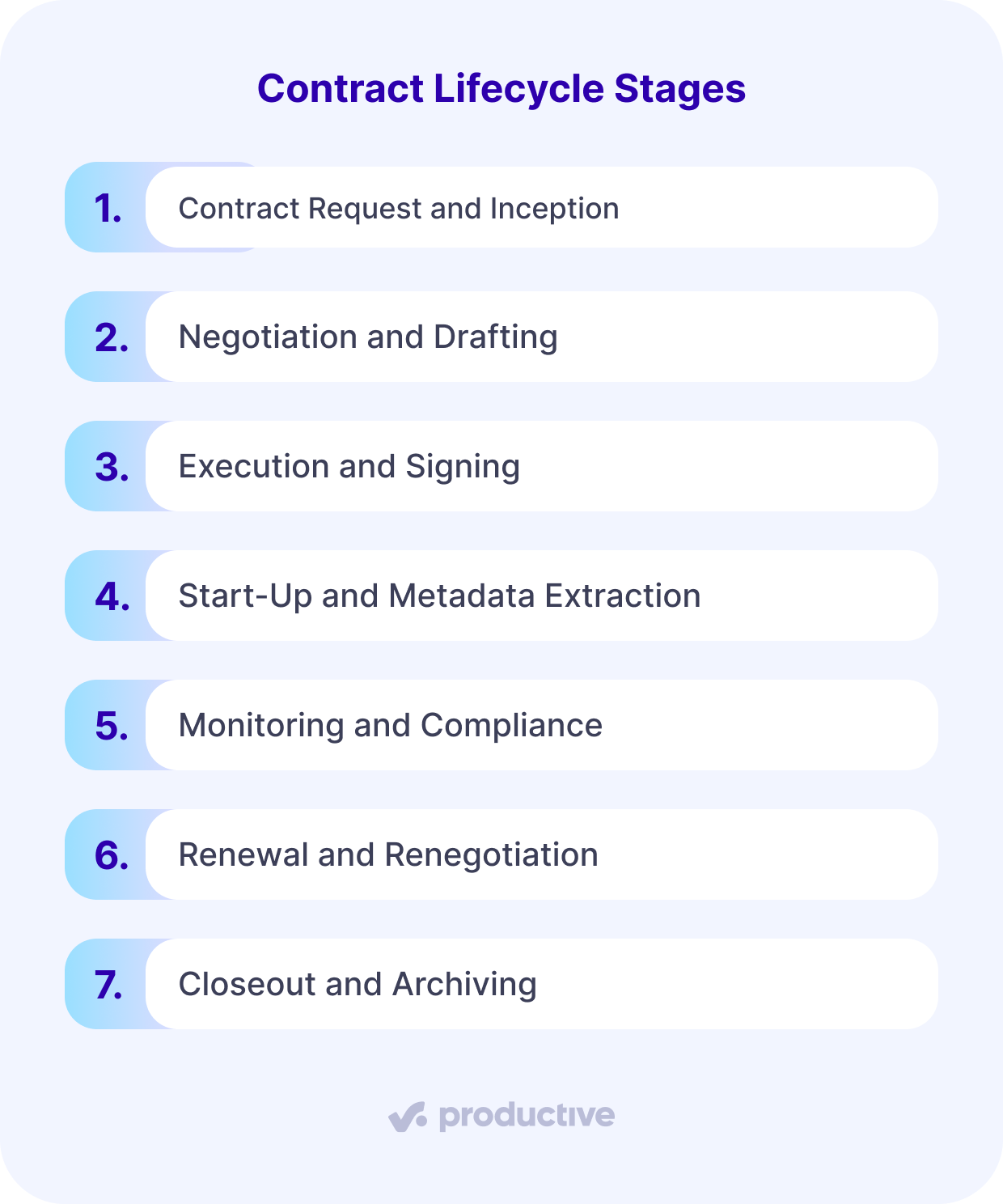
Stage 1: Contract Request and Inception
This phase begins when a team identifies a business need that requires a formal agreement. They define project goals, outline deliverables, and clarify who owns what. This early planning reduces scope creep and improves alignment before legal drafting begins.
Stage 2: Negotiation and Drafting
Stakeholders agree on key terms like scope, pricing, duration, and service-level obligations. Legal teams do the contract drafting using contract templates and clause libraries to minimize risk.
Standardizing the contract language speeds up contract review and ensures compliance.
Stage 3: Execution and Signing
Once the final draft agreement is approved, signatories review and sign the contract digitally. The executed agreement is stored in a centralized contract repository so all stakeholders can access the final terms. This step ensures traceability and eliminates the risk of using outdated versions.
Stakeholder engagement plays a huge part here, so it might be a good idea to check out our guide to engaging stakeholders.
Stage 4: Start-Up and Metadata Extraction
After signing, teams extract contract metadata such as key dates, financial terms, and renewal triggers. This structured data powers workflows, automated alerts, and reporting. A contract management system reduces errors and improves visibility by automating this step.
Stage 5: Monitoring and Compliance
This phase ensures the organization delivers on its contractual obligations. Teams track milestones, deadlines, and performance using dashboards and alerts. Ongoing reviews help identify compliance risks before they escalate.
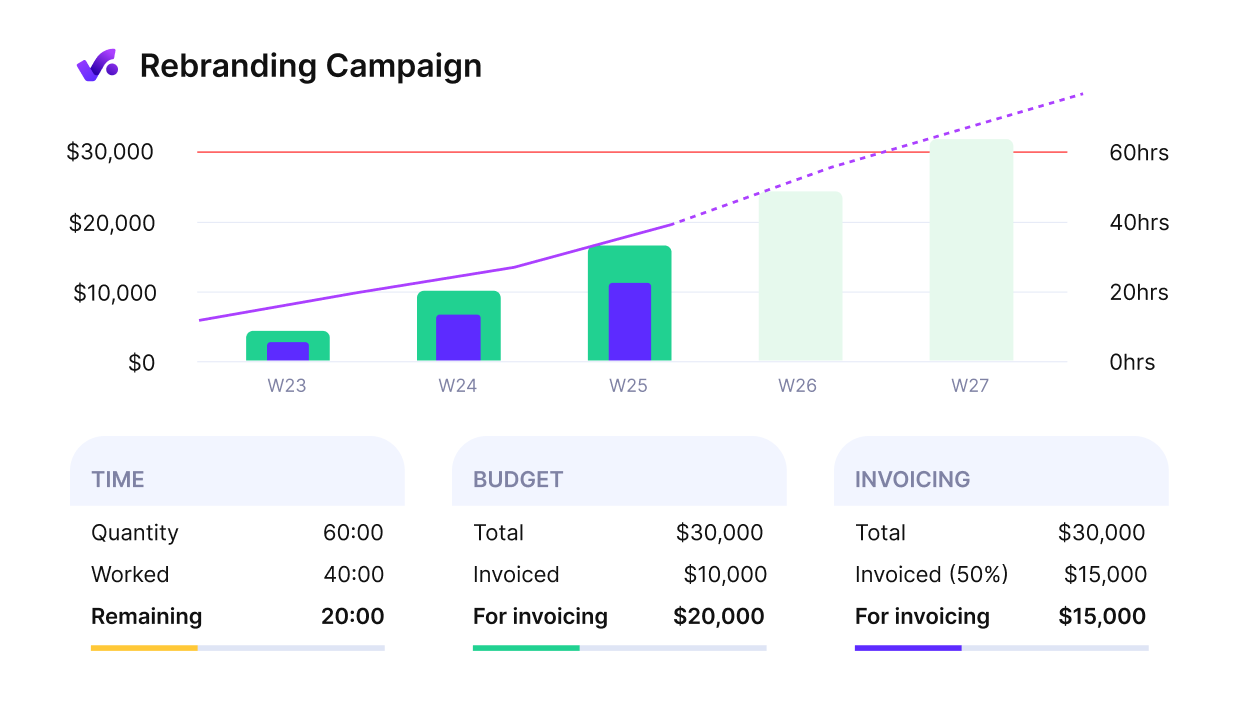
Monitor budget burn and get alerted in case of cost overruns.
Stage 6: Renewal and Renegotiation
As expiration approaches, stakeholders assess vendor or client performance, evaluate costs, and determine if the agreement should be renewed, renegotiated, or terminated. Contract renewal workflows and automated alerts help teams act on time and avoid costly rollovers.
Stage 7: Closeout and Archiving
In the final phase, teams confirm that all contract deliverables were met and obligations fulfilled. The agreement is archived in a searchable contract repository, making it easy to support audits, future negotiations, and reporting.
Manage contracts and all documents with Productive
Who Uses Contract Management?
Legal, procurement, sales, finance, HR, and IT teams all rely on contract management to create, track, and enforce agreements that align with their operational and compliance goals.
Using Loio contract management software can simplify how these departments manage contracts, from drafting to signing, all within one secure platform.
- Legal teams and contract managers ensure compliance with regulations and internal policies.
- Procurement team manages vendor agreements, performance terms, and any other legal obligations related to procurement.
- Sales team accelerates the deal cycle using templates and automated approvals.
- Finance tracks contract value, renewal risk, and billing accuracy.
- HR handles employment contracts, NDAs, and onboarding documentation.
- IT manages service-level agreements and vendor software contracts.
Each department has unique responsibilities in the legal lifecycle. The table below provides a clear overview of who uses contract management and how.
| Department | How They Use Contract Management? |
|---|---|
| Legal Teams | Drafts and reviews using standard contract clauses, manages legal risk exposure, and ensures compliance. |
| Procurement | Oversees vendor contract performance, negotiates procurement contracts, and controls purchasing. |
| Sales | Uses contract templates to accelerate deal cycles and automate the approval process. |
| Finance | Tracks contract value, forecasts revenue, and monitors the terms tied to payment schedules. |
| HR | Manages employment contracts, onboarding documents, and NDA legal agreements. |
| IT | Tracks service-level agreements (SLAs), software licenses, and vendor support contracts. |
What Are the Benefits of Contract Management?
Effective contract management improves compliance, speeds up contract execution, and ensures business agreements deliver measurable results.
According to a World Commerce & Contracting study:
Organizations can lose more than 9% of annual revenue due to poor contract management practices.
Improved Compliance
Contract management gives teams the visibility, control, and accountability they need to protect revenue and stay compliant. When businesses follow a structured contract process, they reduce risk, increase transparency, and unlock more value from every agreement.
Less Revenue Leakage
Missed milestones, auto-renewals, and vague deliverables reduce profitability and increase risk. Contract management software helps stop revenue leakage by enforcing terms, automating renewal reminders, and flagging underperforming agreements.
It also makes your contract workflow more efficient and less costly or time-consuming.
Centralized Contracts
When contracts are stored in a repository of a centralized contract management system (or in a contract tool), legal teams and contract managers have full visibility into contract status, performance, and key obligations.
Real-time access helps avoid delays and ensures accountability.
How Does Agreement Management Improve Operational Efficiency?
Contract management increases operational efficiency by reducing creation time, automating the contract approval process, and improving collaboration across departments.
The table below breaks down the most important improvements and how they support operational performance.
| Efficiency Area | How Contract Management Helps |
|---|---|
| Drafting and Execution Time | Uses templates and clause libraries to create contracts faster; digital electronic signatures eliminate delays |
| Automated Workflows – Approval Process | Automates contract approval workflows and routes each agreement to the right stakeholder |
| Notifications and Tracking | Sends alerts and reminders to prevent bottlenecks and missed actions, improving contract tracking |
| Team Collaboration | Centralizes contract data and status updates, keeping legal, sales, and finance teams aligned |
What Issues Does Agreement Management Help You Solve?
Contract management helps organizations fix common issues like unclear contract terms, missed obligations, policy violations, and slow contract negotiation cycles.
1. Fix Inaccurate or Vague Terms
When teams draft from scratch or skip legal review, contracts often include unclear responsibilities or scope. This causes delays and disputes. Use templates and a clause library to standardize language and improve clarity.
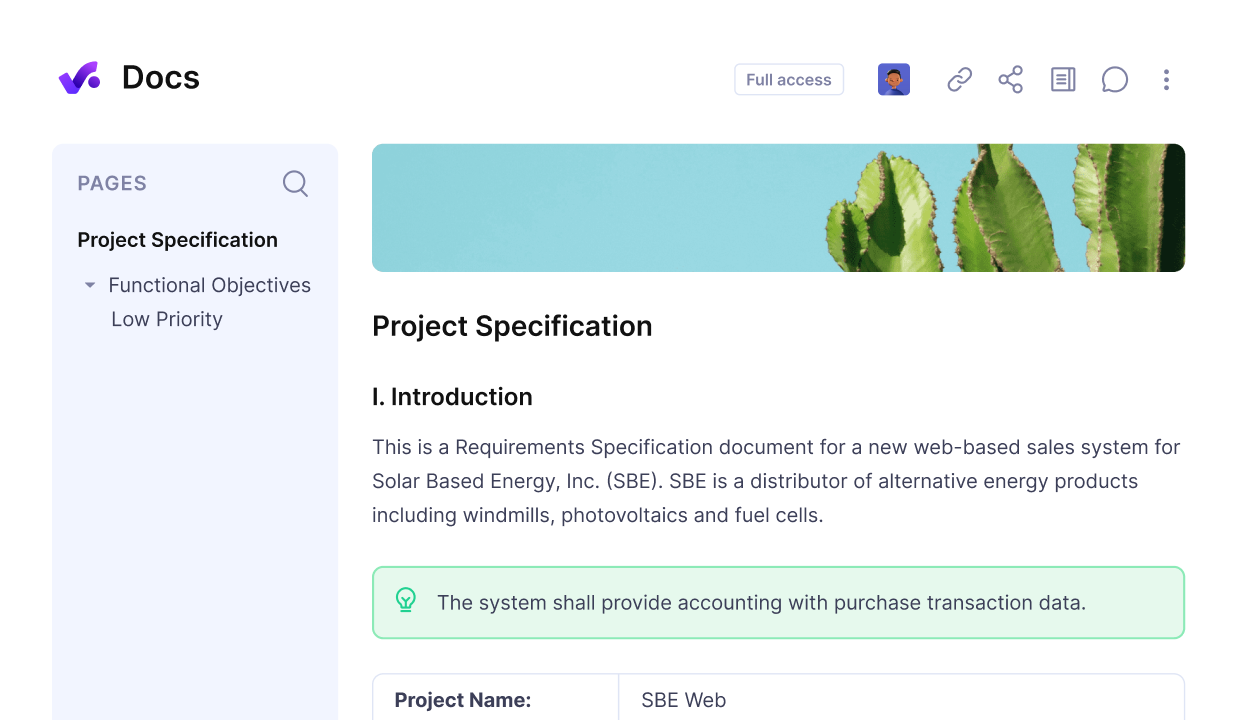
Centralize all legal and project documents, edit, share, and collaborate on Productive’s docs.
2. Eliminate Cross-Team Miscommunication
Without centralized tools, legal, sales, finance, and procurement teams operate in silos. This leads to duplicate work, outdated versions, and missed deadlines. A shared contract repository with real-time status updates keeps everyone aligned.
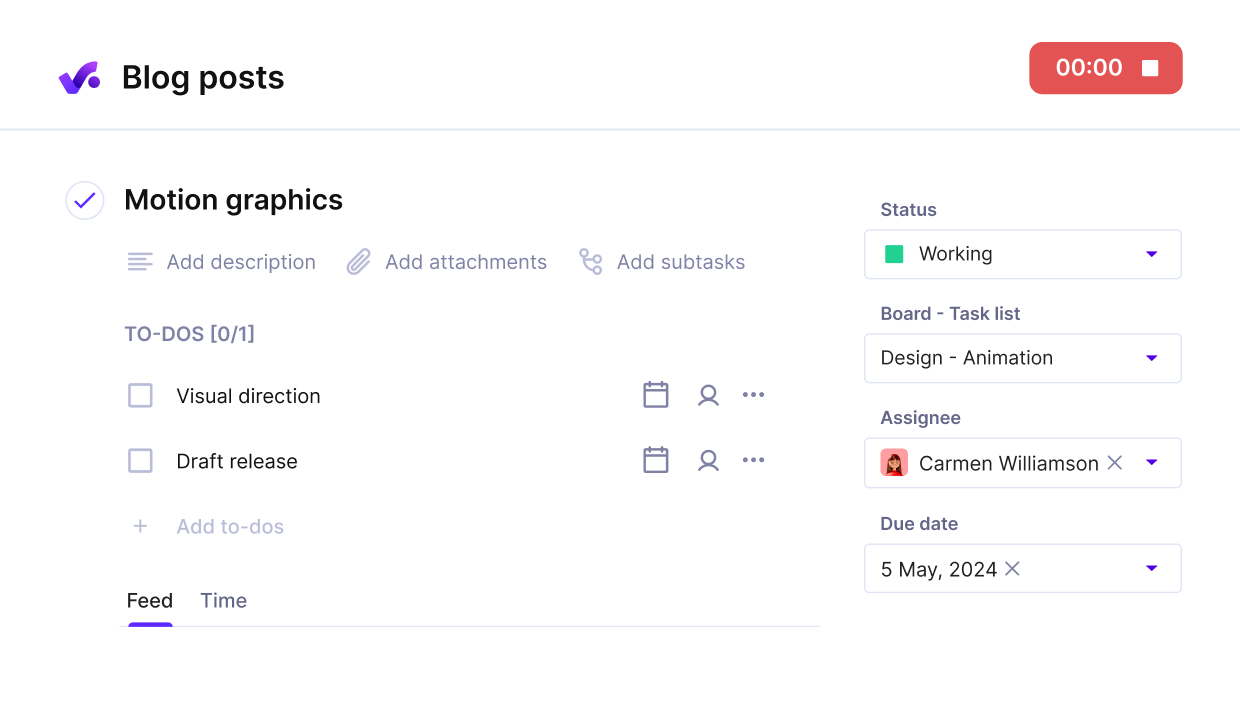
Add detailed task descriptions with assigned owners and due dates.
3. Prevent Policy Violations
If contracts bypass approval workflows or include unauthorized edits, the organization risks non-compliance. Role-based access controls and automated routing ensure the right people review and approve each contract.
4. Speed Up Negotiations
Long email chains and unclear ownership slow down the negotiation process. Define clear review steps, assign contract owners, and use version control to streamline collaboration and reduce turnaround times.
5. Use Templates to Create Contracts Faster
Pre-approved templates reduce drafting time and improve accuracy. They standardize contract language and allow non-legal teams to generate compliant contracts without delays.
6. Send Alerts and Deadline Reminders
Automated reminders notify teams of expiring contracts, contract renewal windows, and review dates. Alerts help prevent missed actions and keep the the project on track (also from a legal point of view).
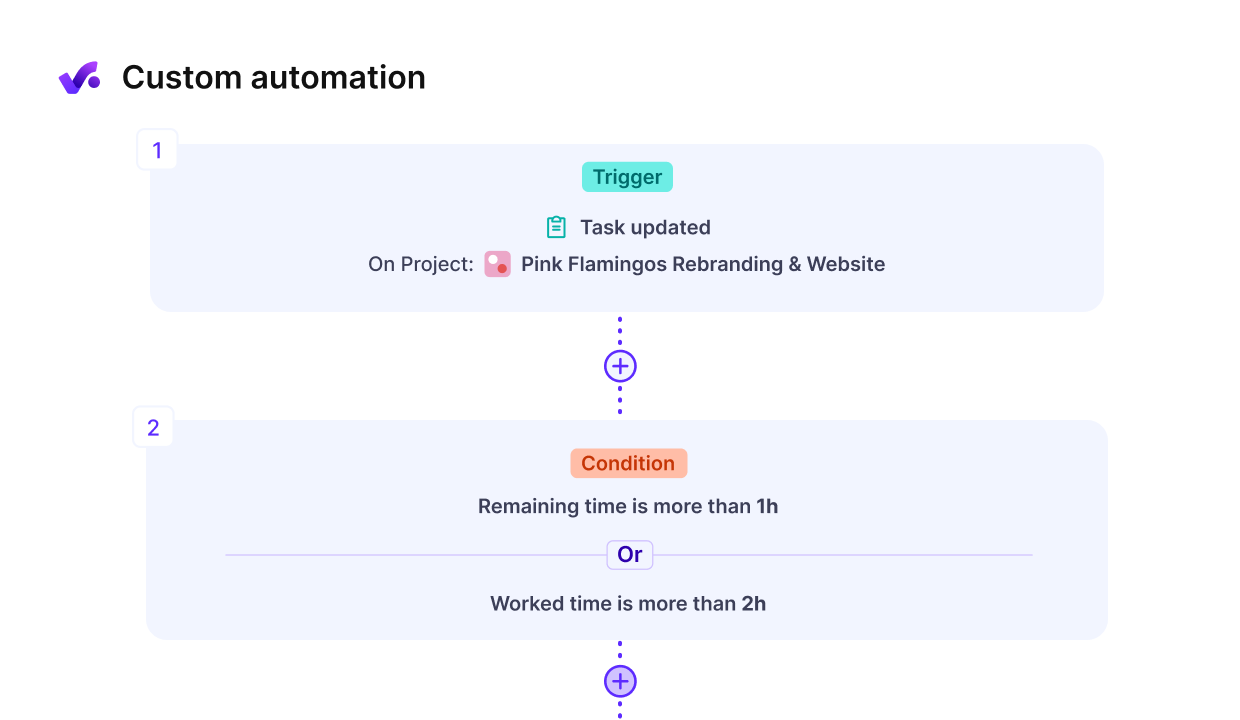
Use Productive to set reminders and automate the renewal process.
7. Manage Approvals and Version Control
Automated approval workflows ensure each agreement is reviewed by the right people in the right order. Version history and access controls help teams track changes and stay audit-ready.
8. Track Performance with Contract Dashboards
Use reporting tools to monitor performance by value, status, compliance, and milestones. Dashboards help teams stay proactive, avoid missed obligations, and support vendor and client accountability.
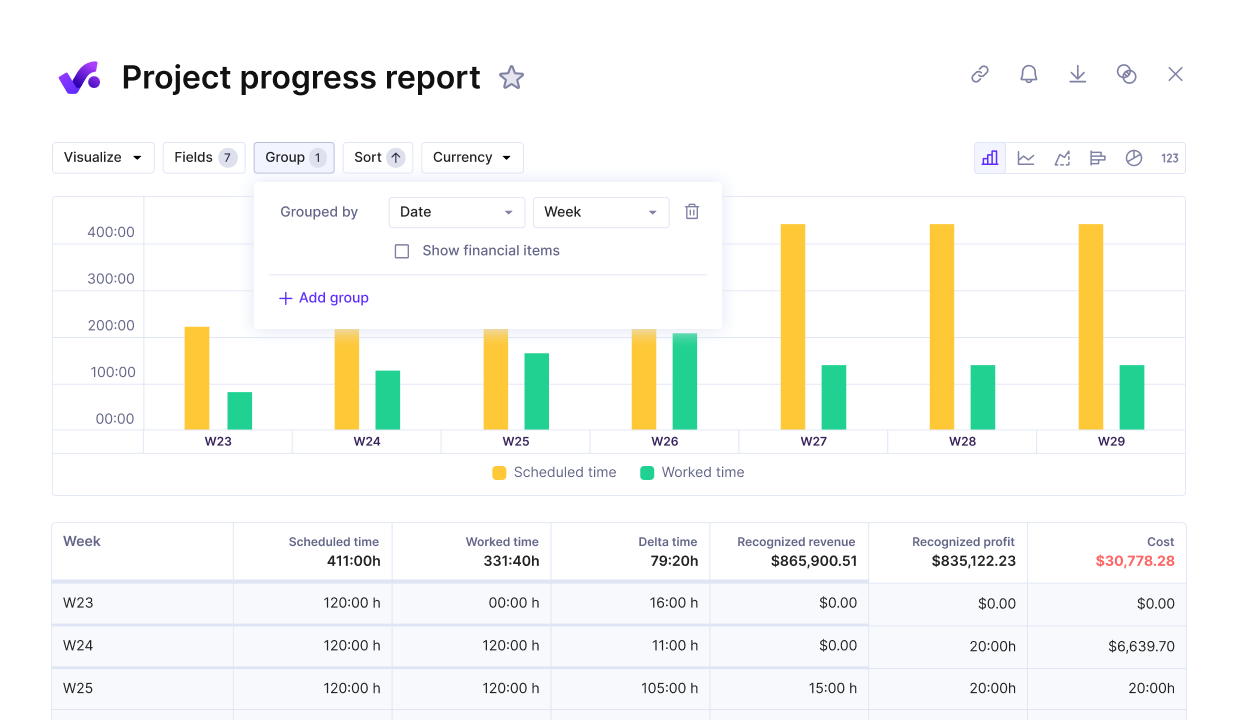
Use Productive’s dashboards to get a real-time report on your ongoing projects.
What Are the Best Practices for Contract Management?
The best practices for contract management include standardizing workflows, automating where it matters most, linking contracts to financial data, and making ownership visible across teams.
Below, we’ll break down of the best practices with more context and low-key tool suggestions.
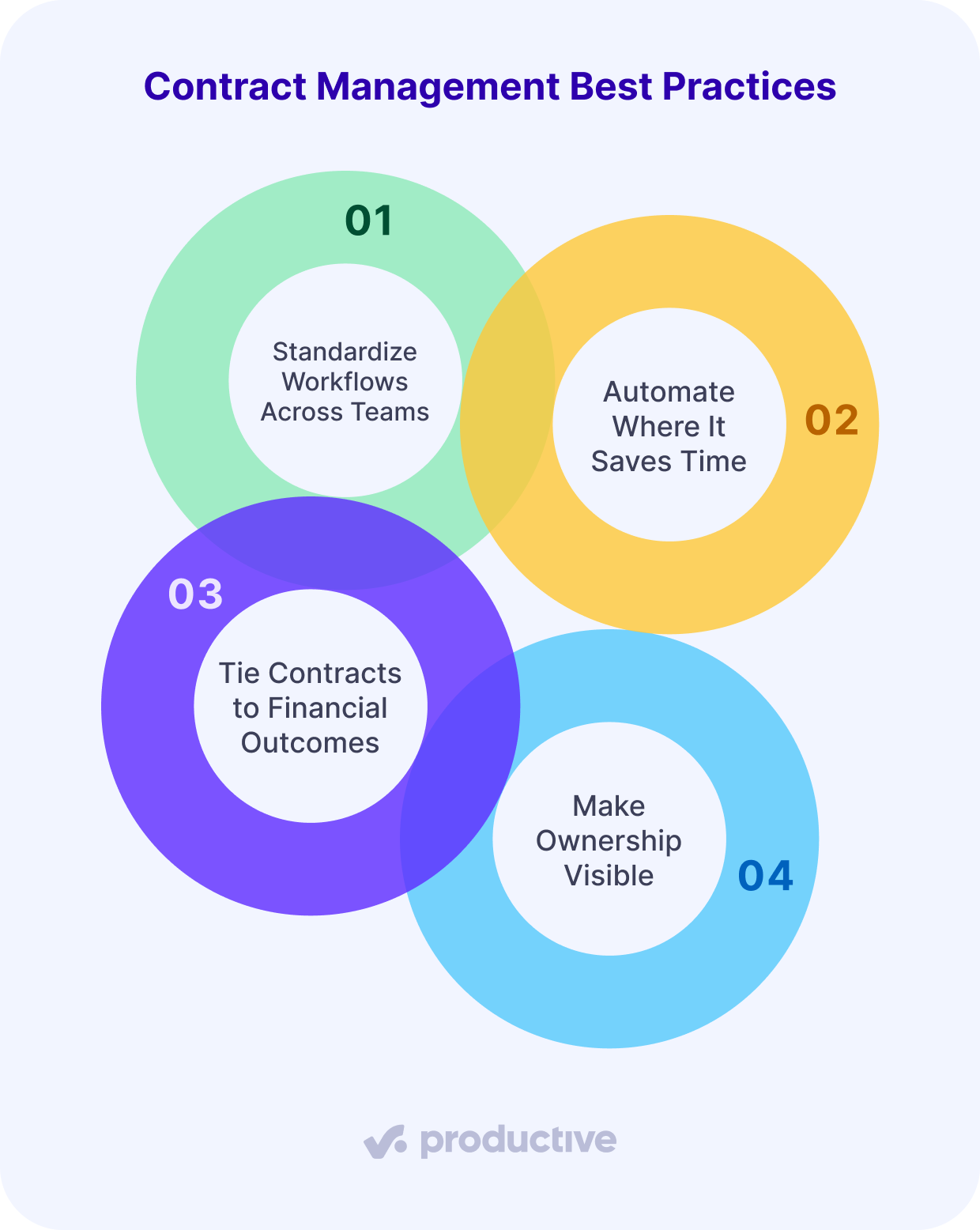
1. Standardize Workflows Across Teams
Use the same templates, approval rules, and naming conventions across legal, finance, sales, and ops. This reduces errors and speeds up training. In Productive, everyone follows a shared structure that supports compliance and clarity.
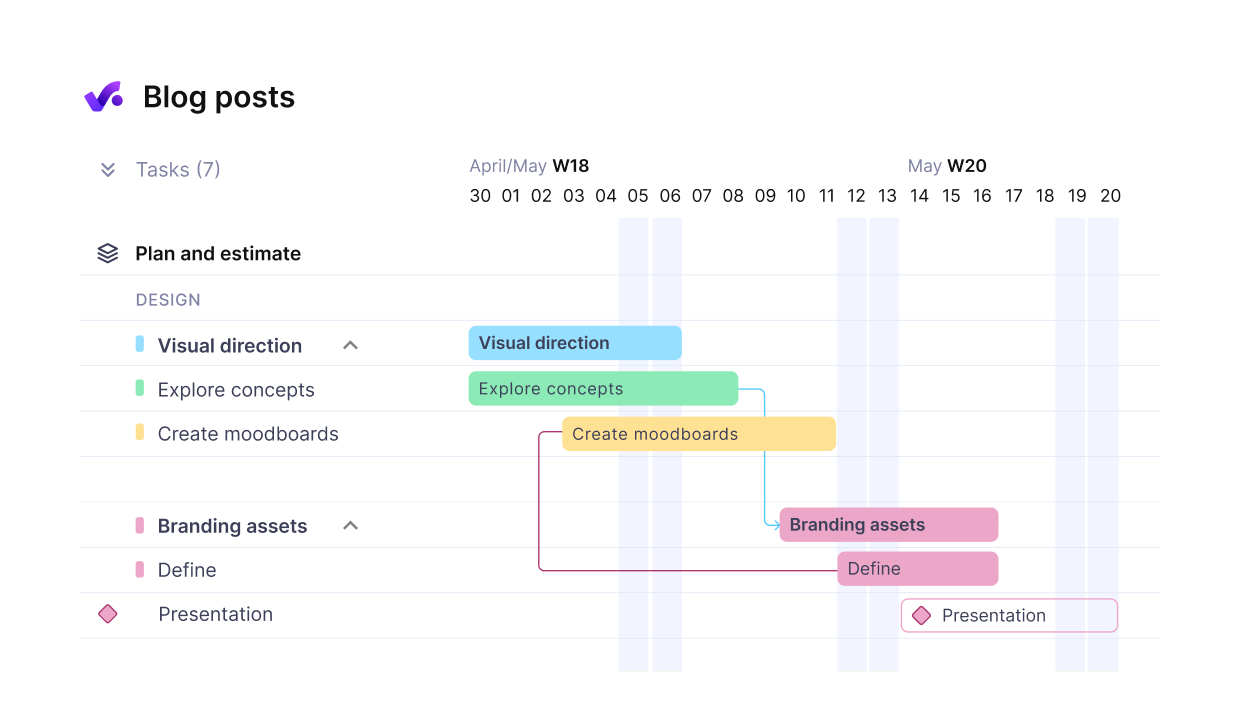
Standardize team workflows in Productive.
2. Automate Where It Saves Time
Automate approvals, alerts, and contract routing to cut delays and prevent forgotten tasks. Use triggers tied to project stages, like in Productive, where you can connect contract alerts to delivery milestones or budgets.
3. Tie Contracts to Financial Outcomes
Don’t let contracts live in a vacuum. Link them to forecasts, spend, and invoicing. Productive connects contracts to actual project budgets and client profitability, so you can see value and risk in one place.
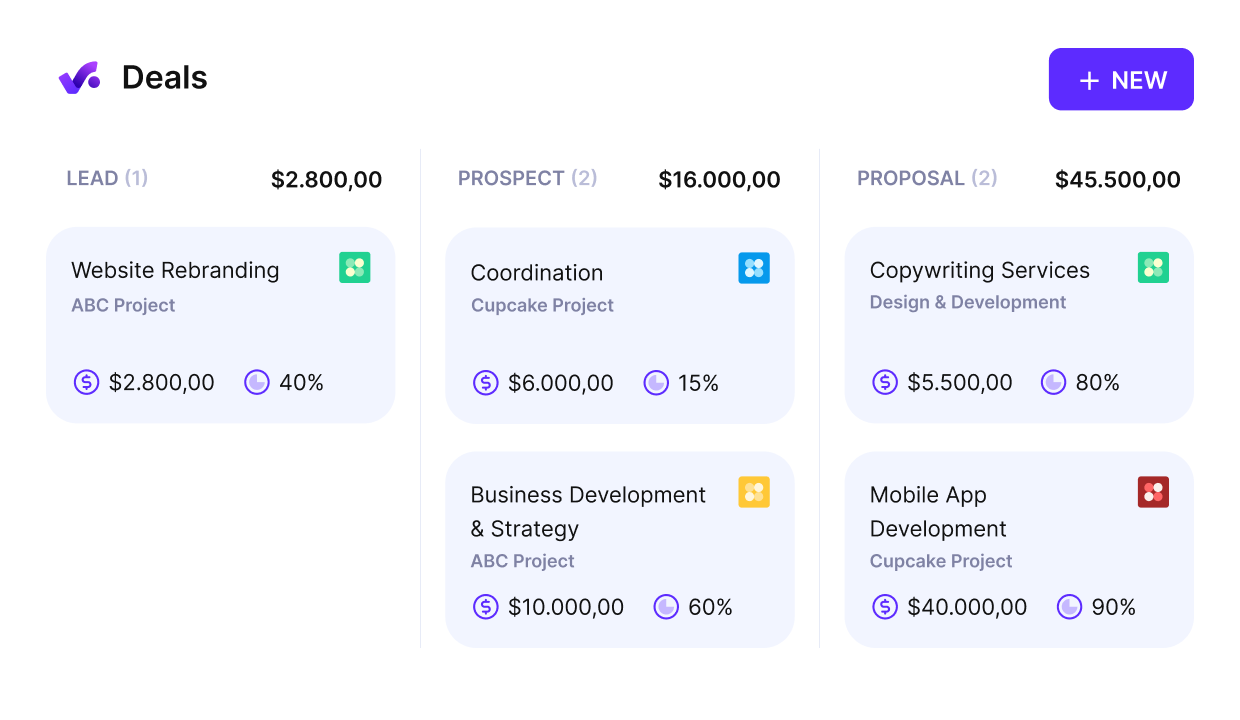
Productive also gives you an overview of your sales funnel and upcoming projects.
4. Make Ownership Visible
Assign contract owners by type or team. Assign contract owners by type or team. Everyone should know who’s responsible for the next steps. Use dashboards and status views, like those in Productive, to show who owns what and where things stand.
How Does Contract Management Strengthen Vendor Relationships?
Contract lifecycle management strengthens vendor relationships by improving oversight, aligning expectations, and creating more consistent renewal and performance cycles.
Below, we’ll expand on how CLM improves how teams create, approve, and collaborate on contracts.
Aligned Expectations
Clear contract terms and defined service-level obligations keep vendors accountable and reduce miscommunication. Contract lifecycle management tools ensure both sides have shared visibility into responsibilities, timelines, and deliverables.
Integrated Vendor Oversight
You can use your contract management software to centralize vendor agreements, monitor service-level obligations, and set alerts for performance reviews. In Productive, shared projects with vendors are linked directly to budgets, helping teams track service value and avoid hidden costs.
Shared Review Cycles
Schedule regular reviews with procurement, legal, and finance to evaluate vendor performance, contract compliance, and service-level delivery. These review cycles help you identify risks, adjust contract terms, and make informed renewal decisions.
How to Choose the Right Contract Management Software?
To choose the right contract management software, prioritize tools that include core features, support visibility, and integrate well with your existing systems. It should be usable across departments, not just legal.
Below, we’ll walk through the specific capabilities that a contract management software should include.
Core Feature Checklist
Look for essentials like clause libraries, contract administration tracking, approval workflows, audit logs, renewal notifications, and dashboards. Platforms like Productive offer additional value by connecting contracts with projects, budgets, and client work.
There’s more actionable advice in our project management software how-to-choose guide.
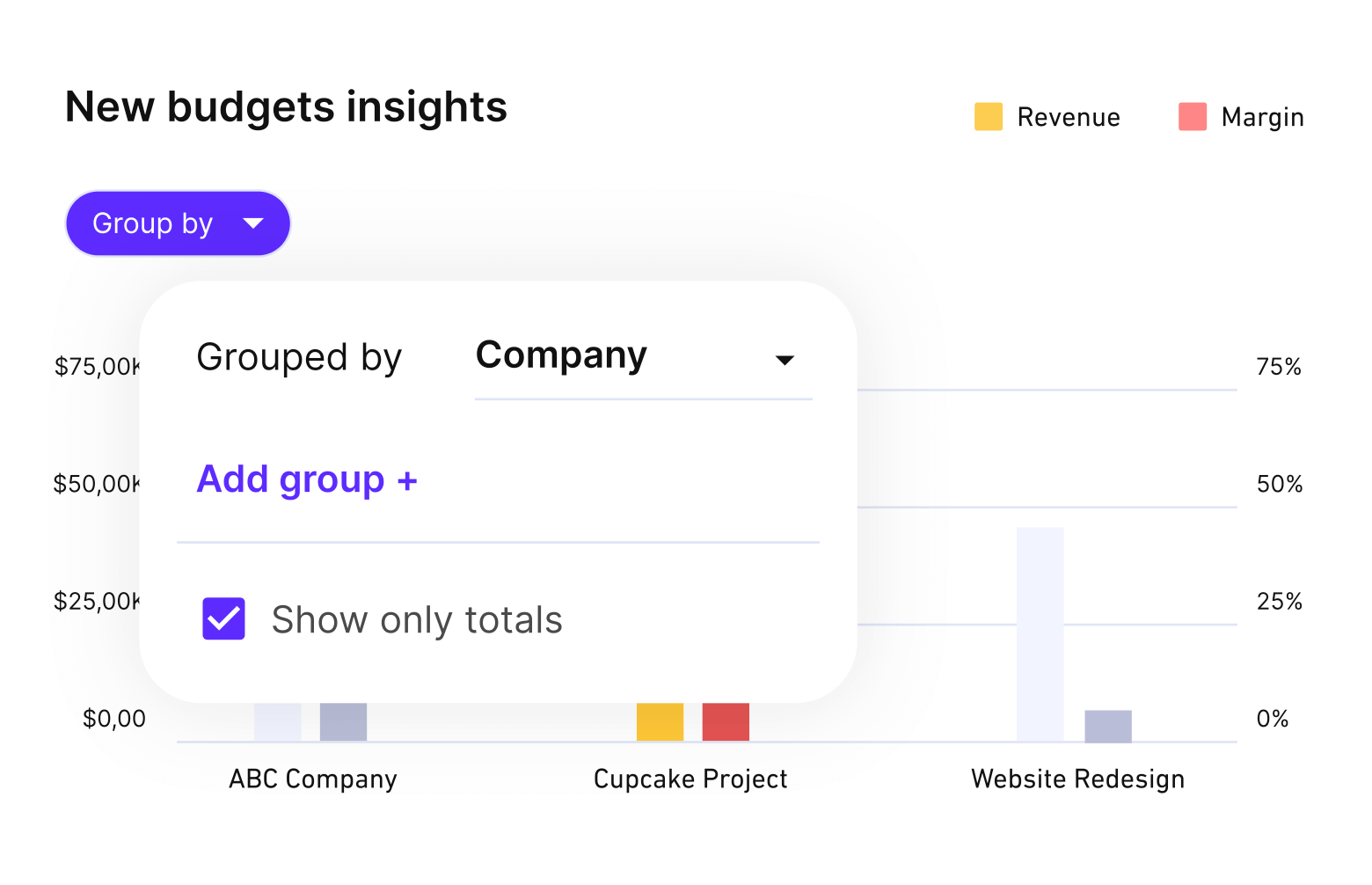
Get full visibility of project budgets and available resources.
Integration with Existing Tools
Choose a contract management system that connects to your CRM system, finance tools, document storage, and project management system. This eliminates duplication and keeps your contract data in sync.
Tools like Productive give you a whole lot more than just a contract management software solution. Productive connects finance, project, and contract management in a single platform for complete business visibility.
Scalability and Ease of Use
The tool should be intuitive enough for any team to adopt, but powerful enough to scale. Look for flexible permission controls, quick onboarding, and a clean UI that teams will actually use.
In case you’d like to know more, head over to our best project management tools list.
Final Takeaway
Contract management gives teams visibility, control, and consistency across every agreement. When you improve how you draft, approve, and track contracts, you reduce risk, protect revenue, and make smarter renewal decisions.
Productive helps you manage contracts as part of your complete project workflows, from onboarding to budgeting to client delivery. You get one platform to draft, track, and review agreements without switching tools or losing visibility.
Book a short demo and we’ll show you how to manage all contracts, project documentation and reduce admin work.
Manage legal contracts of your projects with Productive
Assign owners, set alerts, and connect agreements to project delivery. Draft, approve, and track contracts in one system everyone can use.
